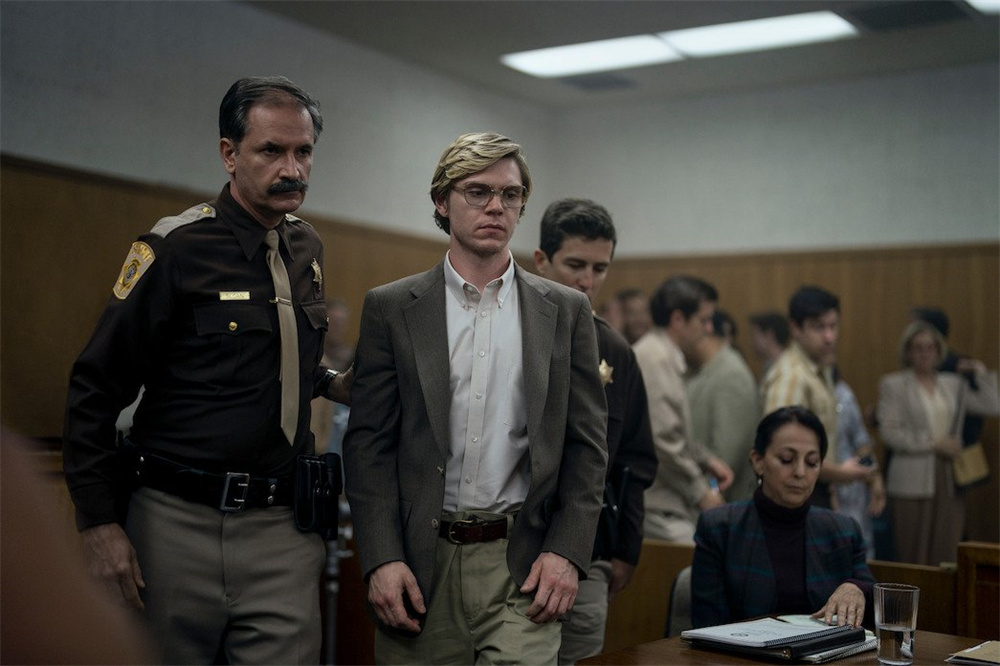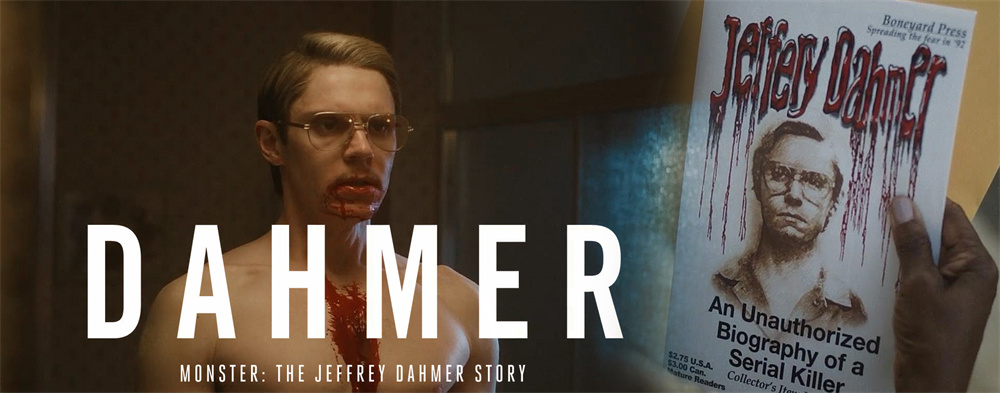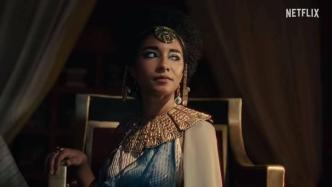
Ryan Murphy and Ian Brennan's new Netflix film "DAHMER - Monster: The Jeffrey Dahmer Story" has Dahmer's name twice in the title alone. The so-called "restoring the victim's life" in the propaganda will not arrive until halfway through the episode.

Ogre Dahmer poster
The length of ten episodes is actually divided into two parts. The first five episodes focus on Jeffery Dahmer's journey to find himself and unleash his murderous nature. The last five episodes shift the focus from individual killers to direct and indirect victims, showing the ills of Milwaukee's police system and political ecology, and the unquenchable American public's passion for serial killers.
At the end of the filming, it seems to be to make up for the feelings invested in resurrecting Jeff Dahmer on the screen. Dahmer's temperament suddenly changed in the prison near the end of his life. The former melancholy and unpredictable killer showed an arrogant and murderous expression. , lost his murderous nature and the mystery that the character has always had, and completely turned into a masked villain. This kind of painstaking efforts to create a character, and then tear it down in order to show that the three views are correct, label him as inherently evil and send him to hell, further exacerbates the sense of separation in "Damo".

Stills of Ogre Dahmer
The first five episodes follow Jeff Dahmer's upbringing in a slow, downward spiral. Several key events make it easy for viewers to stick with the character. It's a dangerous game for serial killer and ogre characters. Jeff Dahmer did well in his high school anatomy class and received the usual rare same-sex recognition. He cheerfully invited his classmates to dissect the pig with him after school, but was contemptuously rejected. Dahmer felt like he was different from everyone else. He tried to blend in in an abrupt way. When taking a group photo of outstanding graduates, he talked to himself and walked into the queue. When he was found, his head was blacked out from the graduation book. Later, Dahmer's mother ran away from home with her younger brother. My father didn't know and didn't care, and he was out with his girlfriend for three months and didn't come home. During this period, Dahmer began to drink heavily, killing the first man in an empty home. He was sent to college by his guilty father, enlisted in the military, and kept changing jobs after being fired from the army, with nowhere to go. Father and grandmother never gave up on him, always believing that "he is a child with good nature".
Almost all of the reviews criticized the procrastination and repetition of the first half of the season. Jeff was always tempted to screw things up, once, twice, three times... knowing that things were going to go bad, and having to repeat the process with him over and over again. The audience, however, was stoked while being tortured. Ryan Murphy's way of shooting is to keep you guessing: whether this murderer still has human emotions.
It was this line of curiosity that kept me watching the first half of the season. If it weren't for the act of killing, "Ogre Dahmer" is almost a gloomy version of a teenage trouble film. Ryan Murphy's royal actor Irvin Peters has a temperament between a handsome young man and a perverted killer. But with so many of the latter roles, frankly speaking, even if he does a good job, playing a serial killer again has lost the freshness of the audience. What's the difference between "Jeff Dahmer" and the other perverted killers Peters has played?

Stills of Ogre Dahmer
Nor does Peters resemble the real Jeff Dahmer. Comparing the photos of Peters and Dahmer shows that they are only similar in appearance. The melancholy of the leading actor in Evans's literary films makes his smiling face charming. Whenever he shows his charm in the disco, he is always on the verge of going out into a play. As if the actor forgot for a moment that he was practicing, he turned to his co-worker with a friendly, considerate and complicit smile.
In reality, Jeff Dahmer's eyes are fierce, and he must not show a fragile look. Irvin Peters uses his charisma to keep this version of Jeff Dahmer hopeful that he might make a different choice every time he crosses a fork -- or let one victim go , or keep a job. This kind of shooting method that arouses the flood of sympathy will definitely make some honest people angry at the creative team, accusing them of exploiting the public's preference for serial killers to sell dog meat and make the young and beautiful victims all the stars. Moon-like set off the only protagonist. Jeff Dahmer, played by Evans, could have been a lovable TV protagonist if he didn't kill people, but also had the courage to laugh at himself and a venomous sense of humor.
At the beginning of the sixth episode, the bow finally turned towards the portrait of the victims. The appearance of Tony Hughes (Rodney Buford), a deaf-mute, brings the appetizing technique to the extreme. The screenwriter first spent 15 minutes telling the life of Hughes before the age of 31. After meeting Damo, the two sparked a spark. Damo's feelings for Hughes were close to normal for a time, and we began to pray, even if the sweetness could not last, at least let Damo let Hughes go. Just like in the previous episodes, we hope very much that the beautiful 14-year-old Laotian boy Konarak will be saved from death. The screenwriter, who understands our preference for beautiful boys, gave these two most beautiful victims a chance to escape, deliberately avoiding their death process, using a liver or an electric drill as a symbol of death. This manipulative method is as effective as Ivan Peters' smile.
After six episodes, Dahmer was close to being arrested, and the writers tried to open up a wider discussion. Discussions about Dahmer's motive for killing are scattered. Whether he himself, his parents, pastors, psychiatrists, police officers or neighbors, he has his own interpretation. No interpretation is satisfactory. The combination of various interpretations makes the motive for the murder a mystery. But this approach is at least honest, and there is no self-righteousness to make up a correct answer for Dahmer.

Stills of Ogre Dahmer
The all-encompassing ambition of "Ogre Damo" blossomed everywhere in the final four episodes. The script presents a contradictory state of mutual benefit between the right and the left. On the one hand, it shows off eating steamed buns with human blood, and on the other hand, it accuses the despicability of this practice, and obtains peace of conscience by flogging social problems.
Granda (Nancy Nash), a black woman who keeps reporting to the police about her next-door neighbor, Jeff Dahmer, is a betrayed hero from start to finish. The screenwriter gave her all the collateral damage, so she specially chose the strong and sturdy Nancy Nash to play, hoping that she could bear everything and live with her head held high. Granda's heartbreak at Konarak's funeral was shared by all who had been wronged. She joined the residents of the Oxford building who slept in public corridors out of fear after the incident, forming a group portrait of the victims who were suffocated.
No matter how loud they speak, they are a crowd whose voices cannot be heard. In one poignant scene, Konarak’s first-generation immigrant father with poor English speaks Lao in court. In an English-speaking environment, his language seemed odd and dragged, and his voice was too loud. He used his habit to start with the hard-hitting history of new immigrants, which was repelled by his lack of public speaking skills. The old judge frowned quietly and interrupted his statement.
The malfeasance of the white police officers led to the death of Konarak, who had been rescued, but they were not punished because of the protection within the police. The two also had the pleasure of making harassing calls to Konarak's father, and white supremacy was more disturbing than Dahmer.
The fanatical interest in Dahmer's letters from his admirers in prison shows the country's propensity for bullying, including the long-maligned supremacy of money.
Money can solve many problems, including soothing wounds to balance the modern inability to deal with them. Decent and upright people are hardly able to deal with unreasonable evil. In the absence of institutional help, they can only express their anger dumbfounded, like a small group of out-of-place people in a mass carnival. The victim's family had nowhere to express their anger, so they wanted to cut off all sources of income for the father and son, including royalties, interview taxes and donations from fans. Beyond that, they are simply powerless to fight this collective act of consuming cruelty for fun. The lawyer suggested that the victim file a lawsuit to obtain compensation, and accept the amount as soon as possible. "Only a settlement can heal the pain and continue to live." Konarak's father, who received the compensation, remained silent and did not give any kindness. He thanked the person who brought the envelope. "Wacky Asians." The divide is always there.
Dahmer's biological parents are the two most realistic characters portrayed in the play. His father began to write an autobiography after his son was arrested, proud of his "quite talent for writing books", and had great expectations for the book's profit. The mother jumped between self-blame, self-pity, and accusing her ex-husband, deceiving herself and expressing her love for Dahmer in her suicide note (in fact, none at all).

Stills of Ogre Dahmer
Although the performance of these social and personal diseases in the second half of the play is superficial, it finally makes sense. It points to another possibility - that Dahmer is a product of society. Dahmer, who belongs to the privileged class, is always easily forgiven, repeatedly killing marginalized people under the protection of the system, and attracting the public because of the horror of handsome appearance and behavior.
Following the traditional values that only the strong can kill the strong, the one who finally killed Dahmo was a mentally ill gangster. The speed with which the official demolition of the Oxford building and the unintentional reconstruction of it as a memorial park is intended to speed up the process of forgetting the memory of the ogre. And since Dahmo was killed in prison in 1994, it is clear that he has not been forgotten.
In the absence of publicity in the early stage, "Damo the Ogre" won the best viewing time on Netflix in its release week. Once it starts, everyone wants to see how it ends (though it's already known). Over the past year, American TV series based on true crime have had a lot of ratings — "Black Bird," "The Staircase," "The Thing About Pam" … what parks and monuments cannot do, is done by the mass media. As for whether the method is mixed with indifference and evil, it is left to the audience to judge for themselves.

